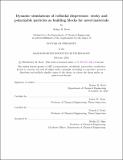Dynamic simulations of colloidal dispersions: sticky and polarizable particles as building blocks for novel materials
Author(s)
Reed, Kelsey M.
DownloadThesis PDF (47.68Mb)
Advisor
Swan, James W.
Doyle, Patrick S.
Terms of use
Metadata
Show full item recordAbstract
The development of new materials is important for societal well being. There has been a great deal of effort recently to integrate experiments, theory, and simulation to accelerate materials discovery, and this broad effort is what motivates this thesis. While there are many different types of materials that are suited for particular applications, one class of materials with a high degree of custamizability is soft materials composed of colloidal particles. These dispersions can be fabricated to respond to a variety of stimuli, including external fields. There have been decades of work using both experiments and theory to investigate the microstructure and material properties of single-component colloidal dispersions. However, composite systems offer an even greater set of possible new materials, especially if the different interactions at play can be controlled and well understood. While there has been more work recently in the area of composite colloidal dispersions and their applications, there has been little focus on the use of processing to achieve different structures. In this thesis, we use Brownian dynamics (BD) simulations to efficiently explore a novel composite colloidal system and two processing schemes that lead to interesting colloidal materials.
Computation can only help to accelerate materials design if simulations include accurate models at modest computational expense. This thesis involves the development of an expression and numerical scheme for calculation of the stress in dispersions of spherical colloidal particles. We show that the quantity we compute differs significantly from that computed using a simpler model, and we also show that the virial stress is incorrect, as one should expect for long-ranged interactions. These results can be used as another tool in the efforts of the simulation community to more accurately investigate polarizable particles via simulations.
The next part of the thesis involves two different simulation studies of a composite colloidal system consisting of polarizable and attractive particles. Control of both attraction strength and applied field strength can be used to dictate particle interactions, and furthermore the role of processing has several different routes. We explore two different promising processing routes, and depending on the processing scheme, different anisotropic gel structures can be formed, and their microstructure further tuned based on the strength of competing interactions. These results highlight the use of simulations to investigate composite colloidal materials formed via specific processing conditions.
Professor Patrick S. Doyle has certified this thesis on behalf of James W. Swan, who passed away in November 2021. I would like to thank Professor Doyle for advising me in 2022-2023 and for certifying this thesis.
Date issued
2024-02Department
Massachusetts Institute of Technology. Department of Chemical EngineeringPublisher
Massachusetts Institute of Technology